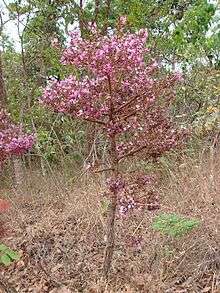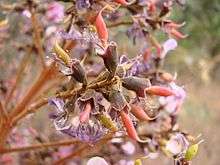Andira
Andira is a genus of flowering plants in the legume family, Fabaceae. It is distributed in the tropical Americas, except for A. inermis, which also occurs in Africa.[2] It was formerly assigned to the tribe Dalbergieae, but recent molecular phylogenetic evidence has placed it in a unique clade named the Andira clade.[3][4]
| Andira | |
|---|---|
 | |
| Andira humilis | |
| Scientific classification | |
| Kingdom: | |
| (unranked): | |
| (unranked): | |
| (unranked): | |
| Order: | |
| Family: | |
| Subfamily: | |
| (unranked): | |
| Genus: | Andira Lam.[1] |
| Species | |
|
See text. | |
| Synonyms | |
| |
Compared to other Faboideae the genus has unusual systems of root nodules[2] and fruits, which are drupes. In most species the fruits are dispersed by bats, and in some they are dispersed by rodents. They may also be dispersed on water.[5]
Plants of the genus are used in traditional medicine in Brazil to treat fever and as purgatives and vermifuges. The treatments are toxic in high doses, however. Chemical compounds isolated from the genus include isoflavones, flavanols, glycosides, pterocarpans, chromone, and ursolic acid.[6]
Species
Andira comprises the following species:[6][7][8][9]
- Andira acuminata Benth.
- Andira anthelmia (Vell.) J.F. Macbr.
- Andira bahiensis N.F. Mattos
- Andira carvalhoi R.T. Penn. & H.C. Lima
- Andira cordata R.T. Penn. & H.C. Lima
- Andira coriacea Pulle—St. Martin rouge
- Andira cubensis Benth.
- Andira cuiabensis Benth.
- Andira fraxinifolia Benth.
- Andira frondosa C. Mart.[10]
- Andira galeottiana Standl.
- Andira grandistipula Amshoff
- Andira handroana N.F. Mattos
- Andira humilis Mart. ex Benth.[11]
- Andira inermis (Wright) DC.—angelin, cabbagebark, cabbagetree
- subsp. glabricalyx R. T. Penn.
- subsp. inermis (Wright) DC.
- subsp. rooseveltii (De Wild.) J. B. Gillett ex Polhill
- Andira kuhlmannii N.F. Mattos
- Andira landroana N.F. Mattos
- Andira legalis (Vell.) Toledo
- Andira macrothyrsa Ducke
- Andira marauensis N.F. Mattos
- Andira micans Taub.
- Andira micrantha Ducke
- Andira multistipula Ducke
- Andira nitida Benth.
- Andira ormosioides Benth.
- Andira paniculata Benth.
- Andira parviflora Ducke
- Andira parvifolia Benth.
- Andira pernambucensis N.F. Mattos
- Andira pisonis Benth.[12]
- Andira riparia Kunth
- Andira rosea Benth.
- Andira sapindoides (DC.) Benth.
- Andira skolemora H. Kost.
- Andira spectabilis Saldanha
- Andira spinulosa Benth.
- Andira surinamensis (Bondt) Pulle
- Andira trifoliolata Ducke
- Andira unifoliolata Ducke
- Andira vermifuga Benth.
- Andira villosa Kleinhoonte
- Andira zehntneri Harms
Nomina Dubia
The following species are of uncertain validity:[7]
- Andira araroba (Aguiar.) See Araroba powder, Mrs. M. Grieve. A Modern Herbal.
- Andira chigorodensis R.T.Penn.
- Andira chiricana Pittier
- Andira harfieldii Leschenault de la Tour
- Andira jaliscensis R.T. Penn.
- Andira macrocarpa R.T.Penn.
- Andira microcarpa Griseb.
- Andira oblonga Benth.
- Andira praecox Arroyo ex R.T. Penn.
- Andira taurotesticulata R.T. Penn.
- Andira tervequinata R.T. Penn., G.A. Aymard & Cuello


References
- Pennington RT. (2002). "(1533) Proposal to change the authorship of Andira, nom. cons. (Leguminosae: Papilionoideae) and to conserve it with a conserved type". Taxon. 51 (2): 385–386. doi:10.2307/1554939. JSTOR 1554939.
- Pennington RT. (2003). "A monograph of Andira (Leguminosae: Papilionoideae)". Syst Bot Monogr. 64: 1–145. doi:10.2307/25027903. JSTOR 25027903. Archived from the original on 2014-02-22. Retrieved 2014-02-14.
- Cardoso D, Pennington RT, de Queiroz LP, Boatwright JS, Van Wykd B-E, Wojciechowski MF, Lavin M (2013). "Reconstructing the deep-branching relationships of the papilionoid legumes" (PDF). S Afr J Bot. 89: 58–75. doi:10.1016/j.sajb.2013.05.001.
- Cardoso D, de Queiroz LP, Pennington RT, de Lima HC, Fonty É, Wojciechowski MF, Lavin M (2012). "Revisiting the phylogeny of papilionoid legumes: new insights from comprehensively sampled early-branching lineages". Am J Bot. 99 (12): 1991–2013. doi:10.3732/ajb.1200380. PMID 23221500.
- Pennington RT, Gemeinholzer B (2000). "Cryptic clades, fruit wall morphology and biology of Andira (Leguminosae: Papilionoideae)". Bot J Linn Soc. 134 (1–2): 267–86. doi:10.1111/j.1095-8339.2000.tb02354.x.
- da Silva VC, de Carvalho MG, da Cunha e Silva SL (2007). "Chemical constituents from roots of Andira anthelmia (Leguminosae)". Rev Latinoamer Quím. 35 (1–2): 13–19. Archived from the original on 2010-05-23.
- "The Plant List entry for Andira". The Plant List. Royal Botanic Gardens, Kew and the Missouri Botanical Garden. 2013. Retrieved 15 February 2014.
- "ILDIS LegumeWeb entry for Andira". International Legume Database & Information Service. Cardiff School of Computer Science & Informatics. Retrieved 15 February 2014.
- USDA, ARS, National Genetic Resources Program. "GRIN species records of Andira". Germplasm Resources Information Network—(GRIN) [Online Database]. National Germplasm Resources Laboratory, Beltsville, Maryland. Archived from the original on 2015-09-24. Retrieved 15 February 2014.CS1 maint: uses authors parameter (link)
- Some sources treat Andira frondosa as a synonym of Andira legalis.
- Different sources disagree on whether the binomial Andira humilis or the binomial Andira laurifolia has priority.
- Some sources treat Andira pisonis as a synonym of Andira fraxinifolia.
| Wikimedia Commons has media related to Andira. |
| Wikispecies has information related to Andira |